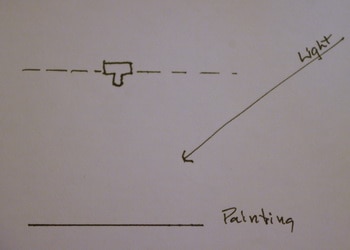I want devote a couple posts to talking about photographing your art work. In this digital age, most organizations require digital images for entry into juried and non-juried shows. Also, it’s a must for documenting your work, should it ever be sold, donated or given away or stolen.
Part I
Important Points in the Process of preparing an image for juried entry:
1. Read the Instructions from the venue carefully. You have to know the requirements of organization or web site. – Most will specify the size, the digital format required (most use JPG) and naming of the file. All of these requirements will need to be met using some software on your computer. Common free programs include, Irfanview, Xnview and GIMP and Picassa. (However I don’t recommend Picassa because it strips the EXIF information which may be required for some entries.) Other programs that entail some expense in order of increasing complexity (and expense) are, Photoshop Elements, Corel Paint Shop Pro, ACD Systems, Serif PhotoPlus, Lightroom and Photoshop Creative Cloud. All of these I think are available in MAC and Linux versions also.
2. Record your image before it is framed. I can’t stress this enough. It’s almost impossible to avoid reflections, frame edges and get correct color balance if the painting is framed. Three-D art work has special needs for even lighting with some shadows. (See suggestions under #4 below.) A good accurate image will help your entry.
3. Make sure your camera looks at your painting exactly square on. (See my drawing–notice the plane of the sensor is exactly parallel to the plane of the painting.) The more accurate you do this now in the camera the easier and quicker it will be editing it later in the computer.

4. Lighting is important for 2-D work as well, most importantly so you don’t get specular highlights from a shiny painting). I use natural daylight as much as possible–either in front of a large window, or outside in the open shade. Cloudy days are especially good because the light is more even, and you don’t have to worry about shadows and a slight blue tint you will get in open shade on a sunny day. Make sure there are no shadows on your work–the results of which on your work are almost impossible to correct in free programs. With 3-d art, some shadows are advantageous in defining the shape and contours of the piece, so some directional light is necessary.
In the next post I’ll mention a bit about cameras and settings.
